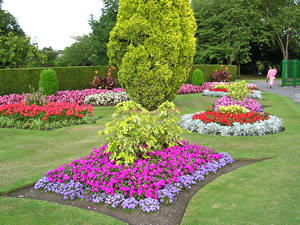
Bedding plants and other small plants are easy to establish in the garden. They are already growing and have an active root system. Plant them in the spring as soon as it is warm enough for the species. But don't rush out with a new flat of plants, and stick them in the ground. First you must harden them off. Most bedding plants are grown under greenhouse conditions and are not yet ready to take on the real world. Here are four critical steps to success.
Hardening off. Toughen bedding plants first to stretch your plant dollars. Hardening off is a physical toughening of plant tissues. It takes only a few days and pays off in the survival rate and vigor of transplants. Whether bringing home plants from the garden center or preparing your homegrown transplants, this is a crucial step. Begin by placing the plants outside for about thirty minutes in a protected site, near a south wall for instance. Even a gentle breeze can seem like a howling gale to pampered plants. The next day increase the plants' time and exposure to the elements. Continue this routine for about a week.
Site preparation. While the plants are hardening off, prepare the site by removing all weeds, turning and amending the soil, and dusting with diazinon or diatomaceous earth to kill soil-dwelling bugs. Transplanting. Transplant on an overcast day or in the late afternoon. Use a garden trowel to dig holes for the transplants 1 to 2 inches deeper than the roots of the plants. Sprinkle a little fertilizer or 1 inch of compost at the bottom of each hole. Refill the hole so that the transplant rests at the same depth it grew in the container. Gently loosen the transplant's roots, and place in the hole. Pat into place, and water. Epsom salts (magnesium sulfate) makes a cheap fertilizer substitute for tomato transplants.
Coddle transplants. Coddle the transplants for a few days even though they have been hardened off. They will suffer less shock and will grow more quickly. Water frequently, but don't drown them. If the weather is windy, give them a wind break by placing a board or bale of straw between them and the prevailing wind. If it gets too hot or sunny, rig a shade cloth over them. A good start will result in more robust and productive plants when they mature.

No comments:
Post a Comment